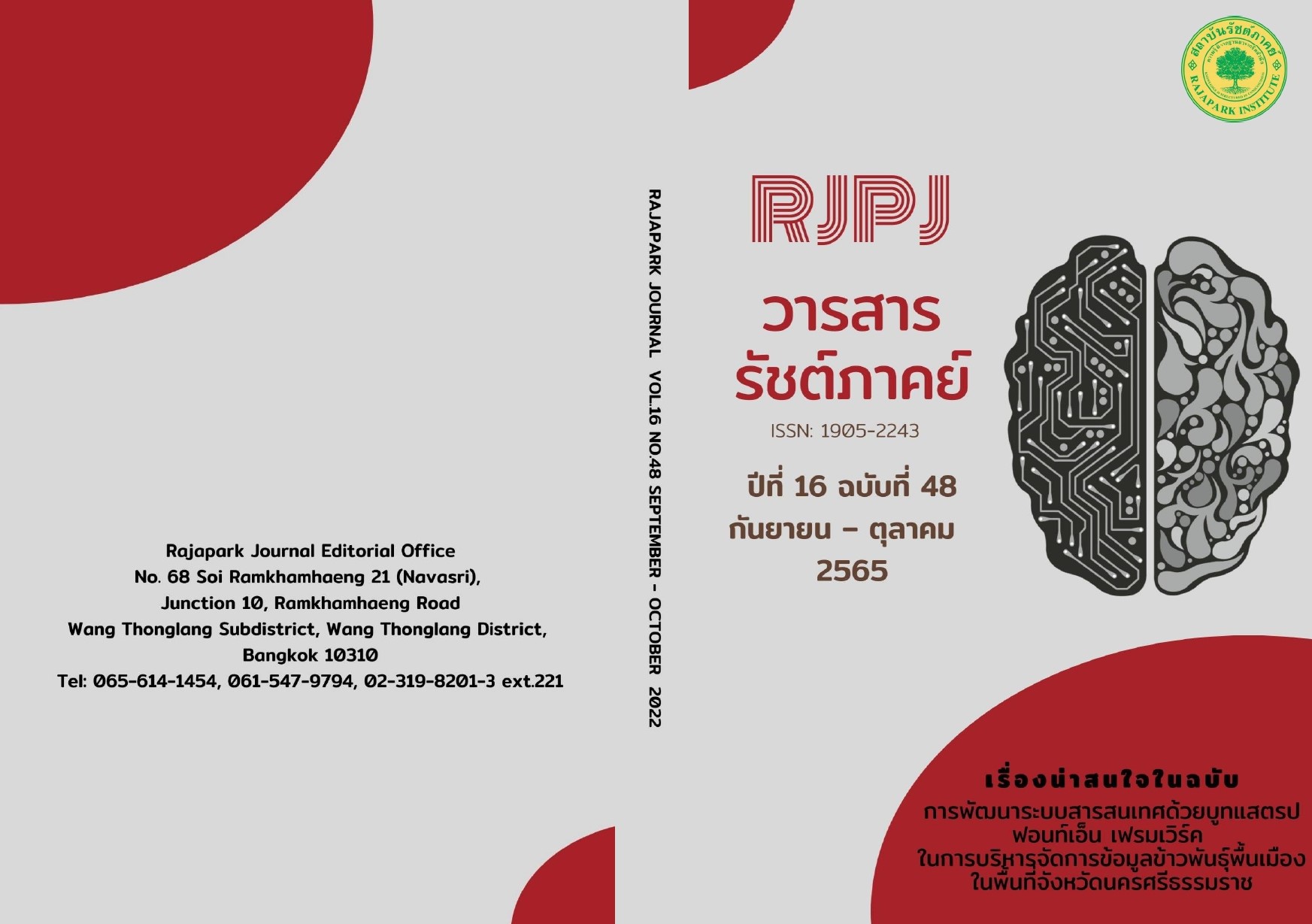ปัจจัยที่มีผลต่อภาวะเจริญพันธุ์ของสตรีไทยในวัยเจริญพันธุ์
Main Article Content
บทคัดย่อ
บทความนี้มีวัตถุประสงค์เพื่อศึกษาปัจจัยที่มีผลต่อภาวะเจริญพันธุ์ของสตรีไทยวัยเจริญพันธุ์ การวิจัยครั้งนี้เป็นการวิจัยสตรีวัยเจริญพันธุ์อายุ 15-49 ปี, 15-24 ปี, 25-34 ปี และ 35-49 ปี และการมีส่วนร่วมในกำลังแรงงานของสตรี ความพร้อมในการดูแลบุตร การมีส่วนร่วมในกำลังแรงงานของเพศชาย และอัตราการขยายตัวทางเศรษฐกิจ เครื่องมือที่ใช้ในการเก็บข้อมูลได้แก่ ข้อมูลทุติยภูมิแบบอนุกรมเวลาตั้งแต่ปี พ.ศ. 2541-2561 และใช้การวิเคราะห์เชิงเส้นแบบพหุคูณ ผลการวิจัยพบว่า 1. การมีส่วนร่วมในกำลังแรงงานของเพศชาย มีความสัมพันธ์ในทิศทางบวกต่อภาวะเจริญพันธุ์ของสตรีทุกกลุ่ม ยกเว้นอายุ 35-49 ปี 2. ความพร้อมในการดูแลเด็ก อัตราการขยายตัวทางเศรษฐกิจมีผลต่อภาวะเจริญพันธุ์ของสตรีในทิศทางลบ และ 3. การมีส่วนร่วมในกำลังแรงงานของสตรีมีผลต่อภาวะเจริญพันธุ์ในทิศทางลบกับสตรีอายุ 25-34 ปี และอายุ 35-49 ปี การขยายตัวทางเศรษฐกิจทำให้สตรีวัยแรงงานอายุ 25-49 ปี มีส่วนร่วมในกำลังแรงงานมากขึ้น ส่งผลให้ภาวะเจริญพันธุ์ของสตรีกลุ่มนี้ลดลง การพัฒนาคุณภาพของสถานรับเลี้ยงเด็กทำให้สัดส่วนจำนวนเด็กต่อจำนวนผู้ดูแลเด็กลดลงและมาตรการส่งเสริมการจ้างงานแรงงานเพศชายมีส่วนให้ภาวะเจริญพันธุ์ของสตรีมีแนวโน้มเพิ่มขึ้น
Article Details

อนุญาตภายใต้เงื่อนไข Creative Commons Attribution-NonCommercial-NoDerivatives 4.0 International License.
ทัศนะและความคิดเห็นที่ปรากฏในวารสาร ถือเป็นความรับผิดชอบของผู้เขียนบทความนั้น และไม่ถือเป็นทัศนะและความรับผิดชอบของกองบรรณาธิการ
เอกสารอ้างอิง
Addati, L., Cassier, N., & Gilchrist, K. (2014). Maternity and Paternity at Work: Law and Practice Across the World. Technical Report. International Labour Organization (ILO).
Alatas, V., & Cameron, L. (2013). The Impact of Minimum Wages on Employment in a Low-Income Country: An Evaluation Using the Difference-in-Differences Approach. World Bank Research Working Paper 2985. Washington, DC: World Bank.
Aly, Y. H., & Quisi, I. A. (1996). “Determinants of Female Labor Force Participation in Kuwait: A Logit Analyses”, The Middle East Business and Economic Review.
Becker, G. (1985). Human Capital, Effort, and the Sexual Division of Labor. Journal of Labor Economics, S33-S58.
Boserup, E., Tan, S. F., & Toulmin, C. (2013). Woman’s Role in Economic Development. Routledge.
Buhari, D. & Mürsel, A. (2017). Female Labor Force Participation Rate and Economic Growth in the Framework of Kuznets Curve: Evidence from Turkey. Review of Economic & Business Studies, 10(1), 33-54.
Cramer, J. C. (1980). Fertility and Female Employment: Problems of Causal Direction. Am. Sociol. Rev, 45(2), 167–190.
Den, D. L. (2001). Work-family Arrangements in Organisations. A cross-National Study in The Netherlands, Italy, The United Kingdom and Sweden, Rosenberg Publishers, Amsterdam.
Dickey, D. A., & Fuller, W. A. (1981). Likelihood Ratio Statistics for Autoregressive Time Series with a Unit Root. Econometrica, 49, 1057-1072.
Fatima, A., & Humera S. (2009). Tracing out the U-Shape Relationship Between Female Labor Force Participation Rate and Economic Development for Pakistan. Applied Economics Research Centre, University of Karachi.
Grace, H. Y. L., & Sing, P. L. (2014). Childcare Availability, Fertility and Female Labor Force Participation in Japan. J. Japanese Int. Economies, 32, 71–85.
Hotz, V. J., Klerman, J. A., & Willis, R. J. (1997). The Economics of Fertility in Developed Countries. In: Rosenzweig, M.R., Stark, O. (Eds.), Handbook of Population and Family Economics. Elsevier, Amsterdam, pp.275-347.
Kanjanajitra, M., Sutthikasem, K., & Tadee, R. (2016). How to Build a Family: Balance the Life and Work of the New Generation. Nakhon Pathom: Institute for Population and Social Research Mahidol University.
Kreyenfeld, M. (2010). Uncertainties in Female Employment Careers and the Postponement of Parenthood in Germany. European Sociological Review, 26(3), 351-366.
Lechman E., & Kaur, H. (2015). Economic Growth and Female Labor Force Participation–Verifying the U-feminization Hypothesis. New Evidence for 162 Countries Over the Period 1990-2012. Economics and Sociology, 8(1), 246-257.
Mason, K. O., & Kuhlthau, K. (1992). The Perceived Impact of Child Care Costs on Women’s Labor Supply and Fertility. Demography 29(4), 523–543.
Mincer, J. (1963). Market Prices, Opportunity Costs and Income Effects. Measurement in Economics: Studies in Mathematical Economics in Honor of Yehuda Grunfeld (Stanford University Press, Stanford, CA).
Nakamura, J., & Ueda, A. (1999). On the Determinants of Career Interruption by Childbirth Among Married Women in Japan. J. Jpn. Int. Econ, 13, 73–89.
National Statistical Office. (2017). Important Conclusions Working for Women in Thailand 2016. Bureau of Economic and Social Statistics. National Statistical Office.
Rica, S., & Ferrero, M. D. (2003). The Effect of Fertility on Labor Force Participation: The Spanish Evidence. Span Econ Rev, 5(2), 153–172.
Sakiko, T., & Maricor, M. (2016). Female Labor Force Participation in Asia: Key Trends, Constraints, and Opportunities. Cornell University ILR School.
Samutchak, P. (2015). Low Birth and Decline in Thai Productivity. Productivity world, 20(114), 54-58.
Santarelli, E. (2011). Economic Resources and the First Child in Italy: A Focus on Income and Job Stability. Demographic Research, 25, 311.
Smith, L. L., & Tickamyer, A. (1978). Nonrecursive Models of Labor Force Participation, Fertility Behavior, and Sex Role Attitudes. Am. Sociol. Rev, 43, 541–557.
Stolzenberg, R. M., & Waite, L. J. (1984). Local Labor Markets, Children and Labor Force Participation of Wives. Demography, 21(2), 157–170.
Tansel, A. (2002). Economic Development and Female Labor force Participation in Turkey: Time-Series Evidence and Cross-Province Estimates. METU/ERC Working Paper No.02/3 Middle East Technical University Ankara, Turkey.
Vlasbom, J. D., & Schippers, J. J. (2004). Increases in Female Labor Force Participation in Europe: Similarities and Differences. Eur. J. Popul, 20, 375–392.
Willis, R. J. (1987). What Have we Learned from the Economics of the Family?. Am. Econ. Rev, 77(2), 68–81.
Willis, R. J. (1973). A New Approach to the Economic Theory of Fertility Behaviour. Journal of Political Economy, 81, S14-S64.


